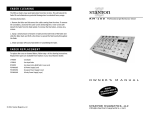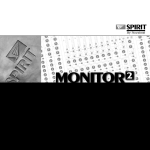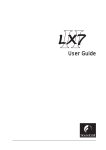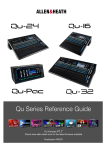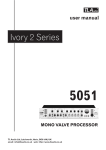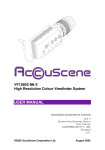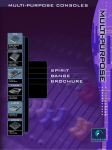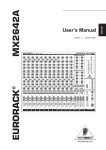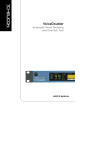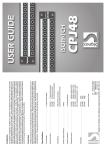Download THE GL2
Transcript
GL2 INTRODUCTION The GL2 continues ALLEN & HEATH’s commitment to provide high quality audio mixing consoles engineered to meet the exacting requirements of today’s audio business. It brings you the latest in high performance technology and offers the reassurance of over two decades of console manufacture and customer support. This user guide presents a quick reference to the function, application and installation of the GL2. For further information on the basic principles of audio system engineering please refer to one of the specialist publications available from bookshops and audio equipment dealers. Whilst we believe the information in this guide to be reliable we do not assume responsibility for inaccuracies. We also reserve the right to make changes in the interest of further product development. SERVICE AND TECHNICAL SUPPORT Under normal conditions the GL2 does not require user maintenance or internal calibration. Any service work required should be carried out by qualified service personnel only. We are able to offer further product support through our worldwide network of approved dealers and service agents. To help us provide the most efficient service please would you keep a record of the console serial number, and date and place of purchase to be quoted in any communication regarding this product. SAFETY WARNING ! Mains electricity is dangerous and can kill. Mains voltage is present within the console power unit. Do not remove the internal power unit or rear cover with mains connected. Check your mains wiring and earthing before switching on. DO NOT REMOVE THE MAINS EARTH CONNECTION! The console chassis is always connected to mains earth to ensure your safety. Audio 0V is connected to mains earth within the power unit. Operating the ground lift switch on the rear panel of the unit will separate audio 0V from mains earth. This switch can be used to avoid problems with ground loops. PRECAUTIONS. l AC POWER: l CONNECTIONS: Use audio connectors and cables only for their intended purpose. Do not connect any source of AC or DC power to the console audio connectors. Do not connect the output of power amplifiers directly to the console. l CLEANING: Avoid the use of chemicals, abrasives and solvents. The control panel is best cleaned with a soft brush and lint-free cloth. To remove stubborn marks (such as chinagraph pencil) isopropyl alcohol may be used. l LUBRICATION: The faders, switches and potentiometers are lubricated for life. The use of electrical lubricants on these parts is not recommended. l DIRT, DUST, SMOKE and MOISTURE: Prevent damage to the moving parts, such as faders and potentiometers, and cosmetics by avoiding drinks spill age, tobacco ash and smoke, and exposure to rain and condensation. Protect from excessive dirt, dust, heat and vibration. Check the power supply label for the correct AC mains voltage setting. Allow adequate space behind the console for ventilation. copyright © 1993 ALLEN & HEATH Ltd. All rights reserved Publication ...................... AP0177 Issue 1 GL2 THE GL2 The ALLEN & HEATH GL2 offers the flexible solution to the many requirements of the live sound and recording environment; whether for conference sound ... in a club ... theatre .. or church ... for touring ... contract hire ... as well as stereo and multitrack recording. The key to this versatility is the unique switching arrangement which configures the console for Front-of-House or On-stage Monitor operation, or a combination of both. 6 Aux sends switchable in combinations of pre or post fader, a powerful 4-band 2-sweep equaliser, dedicated stereo channels, and comprehensive monitoring facilities combine in a compact all metal rack mount chassis to allow total and reliable control of the mixed sound whatever the application. FEATURES The choice of console operating mode at the press of a switch: FRONT-OF-HOUSE t t t t t Wide range 4 band 2 sweep channel equaliser with in/out switch 6 aux send controls with pre/post fader switching on 1-4 and 5,6 Balanced XLR Left, Right and Mono outputs 4 balanced XLR group outputs with subgrouping to stereo Comprehensive master section providing pre or post fader L-R monitoring, auto PFL/AFL, and 2-track record facility. STAGE MONITOR t t t t Balanced mic and line inputs with wide ranging pre-amp and 4-band EQ 6 stage monitor sends with pre/post fader switching on 1-4 and 5,6 6 balanced XLR stage monitor outputs with inserts, metering and signal checking Comprehensive master section providing headphones monitor and separate engineers wedge output RECORDING t t t t 4 group outputs with 4 tape monitor inputs for multitrack recording Separate stereo mix and 2 track record outputs 2 track tape monitoring 10 mono and 2 stereo input channels PLUS t t t t t t t t t MULTIMODE OPERATION configures the GL2 as a stereo + mono F.O.H console with 4 full feature stage monitor sends and 2 effects sends 2 dedicated stereo channels with dual input sources, separate left and right connectors, EQ and full routing 3-point peak indicators on channel inputs Mute switches, AFL checking and peak indicators on group and L-R outputs Inserts on channel inputs, groups and L-R outputs Electronically balanced channel inputs and group, L-R and mono outputs Internal power unit with ground lift switch Compact all metal construction for rack or plinth mount, and adaptable for table top operation. Professional quality assembly with individual circuit assemblies, 100mm long throw faders, and quality components used throughout to ensure continued reliability and exceptional audio performance. GL2 SPECIFICATION 0 dBu = 0.775 Volts RMS 0 dBV = 1 Volt RMS INTERNAL OPERATING LEVEL: -2 dBu INTERNAL HEADROOM: ............ +23 dB MAX OUTPUTS: .......................... balanced +27 dBu 600 ohms max load unbalanced +21 dBu 2kohms max load All console inputs and outputs are in-phase except for the GROUP INSERTS METERS: ..................................... Peak responding bargraph 0VU = +4dBu at XLR outputs PEAK LEDs: ................................. Turn on 5dB before clipping SIG LEDs: .................................... dynamic responding Turn on at -20dBu Width ............... 19.0" standard 19" rack .......... (483mm) Height .............. 19.2" 11U rack space ............. (488mm) Depth ............... 3.5" ........................................... (90mm) weight .............. 21lbs ................... (10.5kg) packed ............. 28lbs ................... (13kg) CONSTRUCTION: All metal chassis. Standard 19" rack mount in 11U space. Single front panel with individual removable circuit assemblies. Removable base for service access. Removable internal power supply unit. FREQUENCY RESPONSE: 20Hz to 20kHz +0/-1dB DISTORTION: . THD 0.01% Line in to mix out at 1kHz CROSSTALK: . output mute better than 100 dB at 1kHz channel mute better than 90 dB at 1kHz fader shutoff better than 90 dB at 1kHz NOISE: ............ 22Hz to 22kHz MIC EIN -127.5 dB into 150 ohms LINE pre-amp at 0dB -88 dBu MIX noise -85 dB ref 0VU POWER REQUIREMENTS: 50/60Hz 40W max Mains voltage set for local requirements. PHANTOM POWER: +48V DC 50mA Channel XLR inputs individually switched CONNECTIONS INPUTS: MIC IN ............................ XLR ............................ pin 2 hot, 3 cold balanced .......... 2 kohms ........... variable -60 to -10dBu LINE IN .......................... XLR ............................ pin 2 hot, 3 cold balanced .......... 10 kohms ......... variable -40 to +10 dBu or 1/4" JACK .................. tip hot, ring cold balanced .......... 10 kohms ......... variable -40 to +10 dBu STEREO IN A ................ 1/4" JACK .................. tip hot, ring cold unbalanced ...... 20 kohms ......... variable -20 to +22 dBu STEREO IN B ................ RCA PHONO ....................................... unbalanced ...... 20 kohms ......... variable -20 to +22 dBu RETURN IN ................... 1/4" JACK .................. tip hot, ring gnd unbalanced ...... >10kohms ........ variable -10 dBV min 2-TRACK RETURN ....... RCA PHONO ....................................... unbalanced ...... >6 kohms ......... -10 dBV INSERT RETURN .......... 1/4" JACK .................. tip send, ring ret unbalanced ...... >6 kohms ......... -2dBu OUTPUTS: L-R OUT ........................ XLR ............................ pin 2 hot, 3 cold balanced .......... 50 ohms ........... +4 dBu +27 dBu max MONO OUT ................... XLR ............................ pin 2 hot, 3 cold balanced .......... 50 ohms ........... +4 dBu +27 dBu max GROUP OUT ................. XLR ............................ pin 2 hot, 3 cold balanced .......... 50 ohms ........... +4 dBu +27 dBu max AUX OUT ....................... 1/4" JACK .................. tip hot, ring gnd unbalanced ...... 75 ohms ........... variable +21 dBu max 2-TRACK SEND ............ RCA PHONO ....................................... unbalanced ...... 1 kohm ............. -10 dBV INSERT SEND ............... 1/4" JACK .................. tip send, ring ret unbalanced ...... 75 ohms ........... -2 dBu . +21 dBu max MONITOR OUT ............. 1/4" jack ..................... tip left, ring right unbalanced ...... 100 ohms ......... variable +21 dBu max PHONES OUT ............... 1/4" jack ..................... tip left, ring right for stereo headphones 8 to 400 ohms GL2 INSTALLING THE CONSOLE The GL2 fits into an 11U space in a standard 19" rack system. Alternatively the console may be adapted for plinth or table top operation. 19" rack width Provide adequate space behind the rear of the console power unit for ventilation. The panel may feel warm around the power unit. This is quite normal as the chassis acts as a heatsink for the internal power supply components. The two M3 base securing bolts each side align with mounting recesses in the rack system. 11U space Mount the console using 4x M6 bolts each side for maximum strength. These should be provided by the supplier of the rack kit. The height does not include the control knobs (add 20mm) or connector nuts (add 8mm). The rack should allow a minimum side to side clearance of 450mm. The GL2 has two support feet fitted to the front of the base to set the correct angle (14 degrees) for table top operation with adequate clearance for the connectors. Support the rear of the console to achieve this angle. Operation in this way prevents interference with the connectors and takes up the minimum of table space. PRECAUTION ! TO AVOID DAMAGE TO THE INTERNAL ASSEMBLIES DO NOT FIT SCREWS THROUGH THE HOLES IN THE SIDES OF THE CONSOLE. SECURE TO EXTERNAL BRACKETS OR FITTINGS THROUGH THE TOP PANEL RACK MOUNTING HOLES. EARTHING THE AUDIO SYSTEM The console chassis is connected to mains earth via the power cord. FOR SAFETY REASONS NEVER REMOVE THE EARTH WIRE FROM THE MAINS PLUG. The console audio 0V is connected to mains earth within the console power unit by the ground lift switch. To prevent mains born and external interference pick-up on the audio signal it is important that this audio 0V is connected to a good noise-free mains earth, either through the audio cable screens or by linking to a local earth. Multiple earth paths cause earth (ground) loops which may result in audible hum and interference. These may be avoided by making sure that there is only one path to earth from each piece of equipment, disconnecting audio cable screens at one end if necessary. Selecting the ground lift switch on the rear of the console disconnects the console audio 0V from the chassis (mains) earth. This avoids ground loops in situations where the chassis metalwork is in physical contact with another path to earth, (often the case in 19" rack installations), or if audio 0V connects to mains earth elsewhere in the system. Ground lift switch located on rear of the console power unit. Press to disconnect audio 0V from mains earth. GL2 INTERCONNECTIONS Where possible use balanced connections for the channel INPUTs and GROUP, L-R and MONO outputs to minimise noise pick-up. Avoid running audio cables near to mains or lighting cables or thyristor dimmer units, power supplies etc. These may cause audible hum and buzz. The use of low impedance sources significantly reduces interference pick-up. Check the cables for correct wiring to avoid problems with phase reversal and unreliable connection. The GL2 follows the convention for XLR pin 2 and jack tip = signal hot (+). Always use balanced cables when connecting to phantom powered microphones. MAKE SURE THAT THE +48V SWITCHES ARE OFF (UP POSITION) WHEN THE CHANNEL INPUT XLRS ARE CONNECTED TO NON-PHANTOM POWERED OR LINE SOURCES. If ground loops cause problems connect the cable screen at one end only as described below. Balanced outputs may be connected to unbalanced inputs and vice versa by linking the signal cold (-) to 0V ground as follows: t Balanced output to Balanced input - Connect cable screen at destination only. t Balanced output to Unbalanced input - Connect screen at source only. Link the -ve output to 0v at the output connector. t Unbalanced output to Balanced input - Connect cable screen at destination only. Link the -ve input to 0V at the input connector. ADJUSTING THE LEVELS For best performance it is important that the console signal levels are adjusted for “normal operating level”. If too high the signal peaks will be clipped resulting in a harsh distorted sound, and if too low the signal-to-noise ratio is reduced resulting in excessive background hiss. For best results operate the console with the output meters averaging ‘0’ or just below and allowing the occasional high level passage to rise into the red. This results in a nominal console output level of +4dBu with ample internal headroom of +23dB to allow for the peaks. It is advisable to use an attenuator pad if you are connecting the outputs to equipment which does not have input level controls and operates at a much lower level. Simply reducing the fader settings (and hence meter levels) to compensate may result in excessive background noise and breakthrough due to the reduced signal-to-noise ratio. The same applies to the console monitor output used to check the console signals through reference loudspeakers. The monitor amplifier should be matched to the console such that normal control room listening levels are achieved with the monitor LEV control set around position '5' to '7'. Operating at a lower position, say '2' or '3', degrades the output signal-to-noise ratio and may result in audible hum and noise. The console PFL (pre-fade listen) / AFL (after-fade listen) system lets you listen to and check the level of signals at different points in the signal path without affecting the main outputs. Use the channel PFL switches to set up the input levels. This overrides the phones/monitor outputs with the pre-fader channel signal (in mono) and displays its level on the monitor meters. Adjust the channel GAIN controls for an average '0' reading on the meters. Use the aux, group and L-R AFL switches to check the post master fader mix levels. Adjust the channel faders for optimum mix level. The normal operating setting of the faders is at the '0' position, allowing 10dB of boost to the top of travel. The red channel and group, L-R PEAK indicators give instant warning of potential signal overload. These illuminate 5dB before clipping. Reduce channel gain or fader settings as appropriate. Each Group fader has a meter ladder showing signal presence (dynamic indication starting at -20dB), 0dB level, and peak (5dB below clipping). OPTIONS AUX SENDS: Aux 1-4 and aux 5,6 are switched pre or post fader using panel switches to satisfy most applications without the need to access internal circuits. Pre-fade is set pre-EQ and post-mute as standard. Contact your service agent should you require alternative settings. An option is available to balance the aux jack outputs. Note that the standard aux outputs are low impedance high level line signals which are interference free and do not require balancing unless extremely long cables are connected in the presence of high level interference and hum fields. The options should be fitted only by competent technical personnel who have reference to the GL2 service manual. CONSOLE EXPANDER: The GL2 Sys-link option may be installed such that two GL2 consoles operate as one in a master/slave arrangement. This is not a user fitted option. Contact your service agent for details. GL2 INPUT MATCHING THE INPUT PRECAUTION ! ALWAYS MAKE SURE THAT +48V SWITCHES ARE OFF (UP POSITION) WHEN THE CHANNEL INPUT XLRS ARE CONNECTED TO NON-PHANTOM POWERED OR LINE SOURCES. A wide-ranging padless input pre-amplifier matches the connected audio source to the console. Use the PFL system to set GAIN for the correct internal operating level (0dB on the meters). Centre position provides +10dB line gain. MIC/LINE selects a balanced mic or line XLR source. Connecting to the additional 1/4" jack balanced line input automatically overrides the XLR line input. For MIC INPUT only connect to the XLR socket. Select MIC (or LINE to provide a 20dB pad for very high output microphones). For LINE INPUT only connect either to the XLR or jack connector and select LINE. For MIC AND LINE INPUT selectable using the switch connect mic to the XLR and line to the jack socket. Individual +48V phantom power switches are located on the rear panel, recessed to prevent accidental operation. Use only with phantom powered microphones connected with correctly balanced cables. 4-BAND EQUALISER Shelving HF, LF and two wideband peak/dip mid sweeps provide 14 dB of cut and boost. EQ IN switches the equaliser in or out of the channel path. Centre detents set the response flat. The normalled INSERT socket provides a pre-EQ -2dBu break point for inserting an external efftects or signal processing device into the channel path. This may also be wired as a pre-fade direct output by linking send to return in the plug and tapping the signal from this point. Use the PFL system to match the inserted device to the operating level of the channel. 6 AUX SENDS 6 individual sends with 1-4 and 5,6 switchable pre/post fader provide effects and foldback sends for recording or F.O.H., or monitor mix sends for ON-STAGE console operations. Internal links for the pre-fade sends are set as standard to pre-EQ (post-EQ option) and post-mute (pre-mute option). ROUTING Centre detented PAN positions the signal between L (odd) and R (even) of the selected groups/L-R mix. This positions the signal as required in the stereo image, or may be used to route to single mono outputs only. The 100mm long throw FADER provides a further 10dB boost above the normal ‘0’ operating position. MUTE switches the channel off. CHECKING THE SIGNAL The red PEAK LED warns of potential overload 5dB before clipping at any of 3 key points in the channel path. Pressing PFL routes the pre-fade signal to the console monitor/meter system to check sound quality and gain setting. The PEAK LED will illuminate at HALF brightness when the PFL switch is pressed. GL2 STEREO MATCHING THE INPUT For INPUT A set the IN A/B switch up. For INPUT B set the IN A/B switch down. MONO combines the left and right inputs to mono the source, or may be used to input a mono source to the stereo channel path. The GAIN control allows a wide range of equipment to be correctly matched to the console. 4-BAND EQUALISER Shelving HF and LF and two fixed frequency peak/dip mid controls provide 14dB of cut and boost. EQ IN switches the equaliser in or out of the channel path. Centre detents set the response flat. DUAL INPUT 6 AUX SENDS The stereo channel features a dual input which selects between two alternate stereo sources. This is ideal for fast switching between stereo sources without the need to re-patch the console. It also allows connection to standard leads with either jack or phono plugs. 6 individual sends with 1-4 and 5,6 switchable pre/post fader provide effects and foldback sends for recording or F.O.H., or monitor mix sends for ON-STAGE console operations. Internal links for the pre-fade sends are set as standard to pre-EQ (post-EQ option) and post-mute (pre-mute option). The stereo channels may also be used for returns from stereo effects processors, providing full EQ, signal checking, routing and feeds to foldback monitors. To avoid feedback do not send the return back to itself through its post-fade aux send. The L and R stereo signals are combined to provide the aux feeds in mono. ROUTING The PAN control changes its characteristics depending on the MONO switch status. In stereo, PAN functions as a balance control, usually to adjust for imbalance in the source. In mono it provides true pan to position the signal in the stereo image. The 100mm long throw FADER provides a further 10dB boost above the normal ‘0’ operating position. MUTE switches the channel off. CHECKING THE SIGNAL The red PEAK LED warns of potential overload 5dB before clipping at the pre-fade L and R channel points. Pressing PFL routes the pre-fade signal in mono to the console monitor/meter system to check sound quality and gain setting. The PEAK LED will illuminate at HALF brightness when the PFL switch is pressed. GL2 GROUP OPERATING MODE The recessed GRP/AUX REV switch determines the way in which the group signal path is arranged. For conventional operation FRONT-OF-HOUSE or RECORDING (switch up) the group mix is routed to the main signal path through the insert, FADER and MUTE switch to the balanced XLR output, while providing subgrouping, AFL monitoring, signal and PEAK metering. The related aux mix routes through the rotary SEND MASTER level control to the 1/4" jack aux output, with AFL monitoring available, to provide an effects or foldback send. With the switch pressed (using a pen tip or similar) the group and aux mix is reversed so that the signal path is optimised for ON-STAGE MONITOR operation. This feeds the aux mix through the main signal path to provide a full feature balanced stage monitor send. In this mode the group mix is rerouted to the related aux jack output through its send master and is available for additional monitor, effects or sub sends. It is advisable to study the GL2 system block diagram to fully understand this flexible routing arrangement. RETURN/SUBGROUP To RETURN processed signals from external effects devices or input additional line signals to the L-R mix, or for TAPE MONITORING during multitracking, set the RET/GRP switch to the up position. Use the LEV and centre detented PAN controls to adjust the level and stereo image. SUBGROUPING enables several sounds to be combined under control of a single fader and then routed to the main L-R mix. To set up a subgroup route the required channels to a group, press the GRPswitch, and adjust LEV and PAN for the desired level and stereo image in the L-R mix. Using the channel and subgroup PAN controls it is possible to set up mono or stereo subgroups. CONTROL OF THE OUTPUTS The main outputs (group or aux mode as selected) are controlled by the 100mm long throw FADERS which offer a further 10dB boost above the normal '0' operating position. MUTE switches off the output. Pressing AFL routes the post-fader signal to the console monitor/meter system to check sound quality and mix level. The AFL signal is pre-mute to allow the output to be muted if required while checking the signal. Each main output has a dedicated post-fader LED metering system. SIG responds dynamically to the audio signal starting to illuminate around -20dB level. 0dB turns on at the console 0dB level (-2dBu internal). PEAK warns of potential overload 5dB before clipping. GL2 MASTER MONITORING THE SYSTEM The PHONES/MONITOR section allows the engineer to listen to L-R (aux 5-6) either PRE or POST the master faders, or 2-TRACK return through up to two pairs of stereo headphones or monitor speaker systems while displaying the selected source on the L and R monitor meters. The peak responding LED bargraph meters are positioned above each group strip. Pressing any AFL or PFL switch interrupts left and right of the monitor with the selected signal in mono and displays AFL (AFL active LED on) or PFL (PFL or AFL+PFL LED on) on both meters. Source selection follows this priority: PFL overrides AFL overrides 2-TRACK overrides L-R PRE overrides L-R POST 2-TRACK RECORD AND REPLAY 2 pairs of phono connectors, SEND and RETURN, allow convenient connection to a 2-track recorder such as cassette or DAT. The send may also be used as an additional unbalanced L-R output. These connections are set as standard for low level operation (-10dBV). For high level recording the balanced L-R XLR outputs may be used. MONO OUTPUT OPERATING MODE The recessed MONITOR MODE switch determines the function of the balanced mono output. For F.O.H. applications (switch up) the main L and R outputs are summed to drive a centre MONO FILL speaker system. Alternatively this output may be used for mono recording or to provide a mono broadcast feed. For ON-STAGE operation (switch pressed) this output becomes AFL interrupted by PFL to drive an engineers WEDGE MONITOR system. The wedge mix is created by pressing the required aux (group) AFL switch combination to listen to the monitor send mix. Pressing any PFL switch allows the engineer to check the channel signals, for example while setting the gains or EQ. On-stage monitor systems usually include a graphic equaliser on each monitor feed adjusted to tune out the resonances which cause acoustic feedback. These equalisers should be patched into the console group inserts so that their effect may be monitored when AFL is pressed. THE MAIN L-R OUTPUTS The L and R output section is identical to the group section with aux reverse switching which configures the main outputs for aux 5, 6 when required. Note that the subgroups always route to the L-R mix and are therefore present at the aux 5, 6 outputs when reverse is selected. It is possible to set up an additional stereo or two mono monitor sends from a combination of monitors (aux) 1 to 4 when SUBGROUP is selected. Alternatively the four return inputs provide a fully independent stereo sub mixer when RETURN is selected. GL2 MONO FRONT-OF-HOUSE conference ... club ... disco ... live shows ... theatre ... church ... touring ... RIGHT LEFT 3 4 1 2 5 FOLDBACK 6 pre-fade aux sends 1 EFFECTS 2 groups 3 4 insert sends returns COMPRESSOR/LIMITERS These are often used to prevent excessive peaks overloading the amplification system, for example in club installations subject to sound level control. This example shows the 4 groups, L, R, and Mono outputs feeding a 7 stack FOH amplification system. The groups provide independent control of the additional left and right loudspeaker stacks, or may be used for separate effects or zone feeds, or for subgrouping to the L-R mix. Select aux 1 to 4 post-fade to access 4 effects processing devices. Use Return inputs 1 to 4 to add the effects to the L-Mono-R outputs. Alternatively use the stereo or mono channels to mix the effects into the groups and foldback as well. Select aux 5 and 6 pre-fade for 2 foldback monitor sends. The channel and output inserts may be used for floating effects and signal processing devices such as compressors, limiters and graphic equalisers. up POST PRE up These switches are recessed to avoid accidental operation. Set using a pen tip or pointed object. Set the MONITOR MODE switch to the up position for mono out (L+R sum). Set the REV switches to the up position for conventional group/LR operation. GL2 ON-STAGE MONITOR On-stage mixing system for local control of performers monitor loudspeakers (wedges) With dedicated output for the stage engineers wedge loudspeaker. STAGE MONITORS 1 6 5 2 3 mic splitter 4 AMPLIFIERS ENGINEERS WEDGE MONITOR Set up the WEDGE MIX by selecting one or a combination of the group/L/R AFL (monitor 1 to 6) switches to listen to the desired stage monitor outputs. These are post insert (post graphic EQ) and post output fader for accurate monitoring. insert Pressing any PFL switch automatically overrides the selected AFL source to allow channel setup and signal checking. EFFECT EQUALISERS to FOH console inserts Graphic equalisers plugged into the console inserts are an invaluable aid to reducing on-stage acoustic feedback and enhancing the clarity of the monitors. Using the inserts allows the stage engineer to check the operation of the equalisers in his wedge monitor. It is best to use the same type of loudspeaker for the engineers monitor as the stage monitors. These switches are recessed to avoid accidental operation. Set using a pen tip or pointed object. This example shows the 6 aux sends routed through the main outputs to provide 6 independent stage monitor mixes with metering, mutes, AFL, inserts and balanced XLR connectors. The REV switches reroute the groups and L-R mix to the aux jack outputs for additional monitor or effects sends, or as an independent submix facility. For example the aux 5 and 6 jack outputs may provide a separate stereo mix output fed from the channel L-R switches and the additional 4 return line inputs. To add effects such as delay or ADT to the stage monitors the signal/s may be routed to a group (available at the aux jack output), using the master LEV to control the send level, and returning the effect to an unused channel using the aux send controls to set the required amount of effect to each monitor. POST down POST down Set the MONITOR MODE switch to the down position (below panel) for the wedge monitor output (AFL interrupted by PFL). Set the REV switches to the down position to route the aux mix through the main outputs to provide the stage monitor sends. GL2 MONO MULTIMODE L-M-R Front-of-House system with 4 dedicated stage monitor sends. RIGHT LEFT 3 4 STAGE MONITOR 2 1 STAGE MONITOR EFFECTS groups (aux 1-4) aux 5, 6 insert return 1, 2 EQUALISERS inserts COMPRESSOR/LIMITERS Signal processors such as these are useful to prevent excessive peaks overloading the amplification system. To tune out stage resonances to prevent acoustic feedback. These may alternatively be positioned on stage in series with the amplifier feeds for performer control. This example shows the GL2 configured to control a Left, Centre, Right Front-of House system with 4 full feature stage monitor sends. Aux 1-4 are set pre-fade for the monitor sends so that the send level is not affected by the F.O.H. mix. Aux 5 and 6 are set post-fade to access two effects devices whose outputs are added to the L-R mix via return inputs 1 and 2. Alternatively these may be returned via the channels, useful for stereo effects devices. The channel and output inserts may be used for floating effects and signal processing devices such as compressors, limiters and graphic equalisers. up pre These switches are recessed to avoid accidental operation. Set using a pen tip or pointed object. Set the MONITOR MODE switch to the up position for mono out (L+R sum) post up down Set the L and R REV switches to the up position for L-R F.O.H. feeds Set the group 1-4 REV switches to the down position to route the aux mix through the main outputs to provide 4 stage monitor sends. GL2 RECORDING stereo amplifier stereo and multitrack ... studio ... live ... location ... audio visual ... production ... LEFT RIGHT MUSICIANS CUE MONITOR LOUDSPEAKER SYSTEM stereo amplifier outputs inputs Y-splitters (or repatch leads as required) 4-TRACK MULTITRACK line ins groups returns 2-TRACK RECORDER send return aux 5 aux 6 COMPRESSOR/LIMITERS Here, a typical small STUDIO RECORDING setup is shown with 4-track multitrack and 2-track mastering recorders (ideal for hard disk and DAT recording systems). The dedicated 2-track sends or the balanced L,R outputs may be used to feed the 2-track. For LIVE RECORDING the channel inserts may be tapped (link send to return) to provide additional prefade direct feeds to a multitrack. PATCHED EFFECT MULTITRACKING: To monitor the track returns select RET and adjust LEV and PAN for the required monitor mix. Alternatively, use the channel line inputs if a dedicated musicians cue feed (aux 5,6) is required. Select aux 1 to 4 post-fade for the effects processors. Two stereo devices are illustrated here with their outputs returned to the stereo channels. Additional floating effects devices may be patched into the channel or output inserts as shown. The additional rear panel phones/monitor output feeds the studio reference loudspeaker system to monitor the console signals and recorded tracks without interrupting the recording itself. STEREO EFFECTS 1 These are often used in location recording to prevent unexpected signal peaks overloading the recorder. Select aux 5 and 6 pre-fade to provide a stereo cue to the musicians headphones. Alternatively these may be set post-fade for additional effects and the L,R outputs used for cue. 2 POST PRE To monitor the group sends to the multitrack select GRP. MIXDOWN: Use GRP for subgrouping or RET for effects returns. Mix the track returns through the channel line inputs. up Set the REV switches to the up position for group (track) and L-R outputs.
















